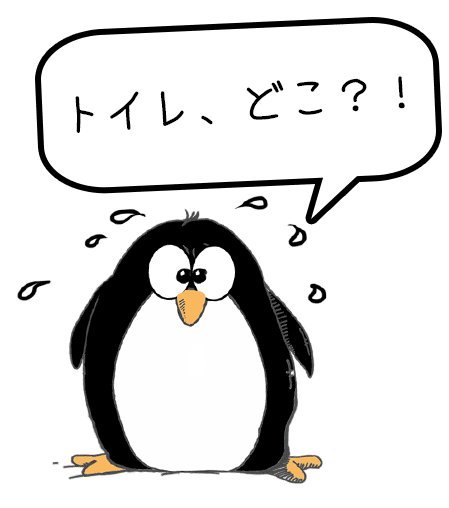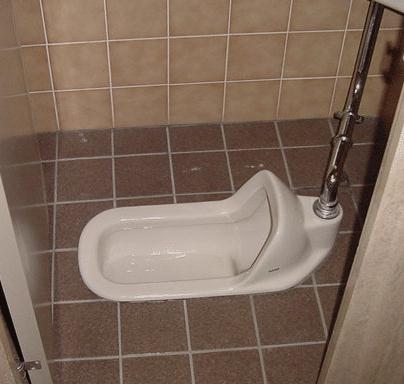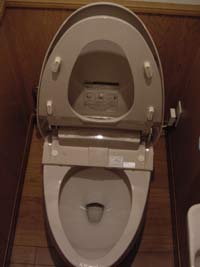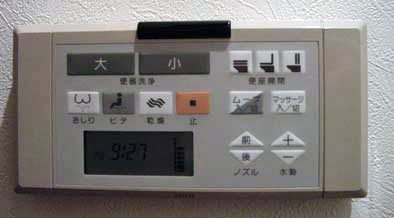Everything you need to know… before you go.
It’s a dirty subject, but let's talk about toilets in Japan.

How to say Toilet in Japanese
First, just how do you say "toilet" in Japanese?
The most common word is simply トイレ toire which is a loanword based on "toilet."
Another common and more polite way to say "toilet" or "bathroom" is お手洗い ote arai. Literally, this means "hand washing" since it is definitely a place one should wash one's hands!
About the Japanese Toilet
Japanese toilets are either very, very high-tech or very, very low tech.
A majority of toilets in Japan are Western style or have the option of a Western-style toilet or urinal (for men, of course). However, you will probably encounter the traditional Japanese-style squat type in older buildings and rural areas.
The Western-style toilets have a lot of buttons that do strange things. These are the fancy toilets with functions like:
- bidet (ウォシュレット Washlet -- a brand name of Toto)
- seat warming (amazing in the winter)
- deodorizing
- blow dryer
- automatic flushing, and
- adjustments for the water jets.
Most toilets have two options for flushing. 小 (small) for "number one" and 大 (large) for "number two." The difference is the amount of water.
Nearly all toilets made in Japan are from a company called Toto. Toto is short for 東洋陶器 touyou touki or "Oriental Ceramics."
The squat type (Japanese style) Japanese toilet

This is referred to as 和式 washiki or "Japanese style."
You walk into the toilet and close the door (let’s hope there is a door). Then turn to face the flusher or the covering (in the photo, face the right) and squat etc.
I bet in all your toilet-life you have never had to use your legs as much as with these toilets. You must not only support yourself, but also keep balance in the right position just before releasing the, uh, package. And be warned, the first time will seem strange to you. But you'll get used to it.
This style, while "low-tech," is surely more hygienic and, with all the squatting, more healthy too.
The Usually Super High Tech (Western style) Japanese toilet

Use this one just as you would back home, EXCEPT… If you can't read kanji, DON’T TOUCH ANY BUTTONS. If you do, you may discover an unpleasant surprise coming up from the depths. These toilets are high-tech. They have seat warmers, bottom washers, and a number of other things you may not be expecting!
A True Story
In 1998, an American friend and I went to a restaurant shortly after arriving in Japan (Neither of us knew much of Japanese or Japan at that time.). He excused himself to visit the little boys room while I ordered my meal. Some ten minutes later, he came back with a pale face.
I said, “Are you okay? What happened?”
He shook his head as if unable to comprehend my question.
He finally blurted out, “Don’t ever touch the buttons on the toilet!”
He claims he screamed loudly when a gush of warm water came unexpectedly from below. I didn’t hear him, but the restaurant was noisy at the time.

Well, that is the bit on toilets in Japan. They really aren’t as scary as I make them out to be, really. Now, let's learn a few vocabulary words related to toilets in Japan. The first few are useful. The last few are for fun.
Toilet words
トイレ
toire
toilet
Probably an abbreviated form of the English "toilet". The most common way to refer to the toilet in Japanese
お手洗い
o te arai
toilet; “(the place to) wash one’s hands”
This is a polite word to use when asking for the bathroom.
WC
Often public restrooms are marked with these two letters. They stand for the old-fashioned way of calling a toilet: “Water Closet”
便所
ben jo
You'll sometimes see toilets marked as 便所. Learning these kanji would be good if you are heading to the more rural areas.
化粧室
keshoushitsu
the powder room
Another polite euphemism for the bathroom. Literally, this is "cosmetics room."
水洗便所
sui sen benjo
A flush-type of toilet
I remember the first time I heard this word. When I was in the JET Programme in the 1990s, I was at school during the morning teacher’s meeting. I kept hearing “SUISEN” over and over again. (推薦 suisen in education means a recommendation for students going to another school upon graduation – but of course, I didn’t know that!) I looked it up in my dictionary and only found ”suisen benjo.” I was puzzled. Why were the teachers talking about about a flush toilet for fifteen whole minutes!? And with such straight faces!
汲み取り便所
kumi tori benjo
the non-flush drop type of toilet; an outhouse|
汲み取り kumi tori - to scoop out; to pump out
便所
benjo - toilet
トイレットペーパー
toiretto pe-pa-
toilet paper
厠
kawaya
Another word for the bathroom. According to the dictionary I am using, the word came from a small hut (や) over a stream or 川 kawa thus kawaya. This word is somewhat dated which might make it fun to use.
雪隠
secchin
Another word for the bathroom
Another outdated term for the toilet.
金隠し
kin kakushi
This originally referred to the part of armor which covered the testicles (金 is a euphemism for the testicles). This refers to the mantle or hood on a urinal or other toilet.
Take a six-question quiz





